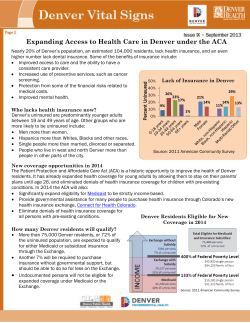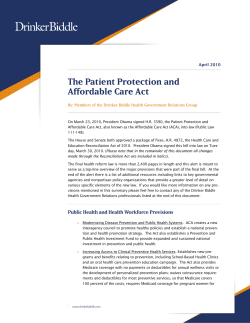
The need to improve population health is critical. This com-
INVITED COMMENTARY The Potential Impact of the Affordable Care Act on Population Health in North Carolina Greg D. Randolph, John H. Morrow The need to improve population health is critical. This commentary explores how the Patient Protection and Affordable Care Act of 2010 (ACA) can help us improve population health, highlights some of the actions North Carolina has taken in response to the ACA’s provisions, and discusses the value of health investments in the future. T he United States faces a critical need for improved population health. Compared with 16 other wealthy countries, the United States ranks last in life expectancy, and the gap between the United States and the top countries has increased over the past 3 decades. Worse, investments in health care in the United States are an abysmal value; the United States spends almost double what other wealthy nations do on health care, with scant improvement in outcomes to show for it [1]. North Carolina, unfortunately, ranks 33rd among US states in overall population health [2]. Adding to this “value crisis” is the unsustainable increase in US health care expenditures, which are spiraling out of control and are expected to reach 19.6% of the gross domestic product by 2021, up from 17.9% in 2010 [3]. Lack of availability of medical care and poor quality of care account for only 10% to 15% of preventable mortality in the United States; the remaining 85% to 90% is determined by factors such as level of education, behavioral choices, the physical environment, and socioeconomic conditions [4]. The sharply climbing costs of health care, combined with the current focus on governmental austerity at the federal, state, and local levels, will make it very difficult to achieve further investments in health. These sobering facts make it clear that fundamental changes are needed in US health policy. The Patient Protection and Affordable Care Act of 2010 (ACA) will cause the most extensive changes in national health policy in decades. In this commentary we outline the provisions of the ACA that can impact population health, describe North Carolina’s actions relating to the opportunities the ACA provides, explore what may be required to improve population health, and discuss the value of our health investments in the future. Provisions of the ACA Relating to Population Health The ACA provides several important opportunities to improve population health. One such opportunity, which is 330 perhaps not well known to the general public, is the Internal Revenue Service’s requirement that nonprofit hospitals complete a community health needs assessment (CHNA) every 3 years and report every year on how they are, or are not, addressing the identified needs [5]. Because local public health departments have been doing CHNAs for many years and have been making efforts to improve community health, this ACA requirement provides a fertile opportunity for hospitals and health departments to collaborate on the assessment and improvement of population health. Another ACA requirement is that a National Quality Strategy be implemented by the federal government and monitored yearly [6]. The National Quality Strategy is framed around the Triple Aim approach created by the Institute for Healthcare Improvement; the 3 components of the Triple Aim are population health improvement, improved quality of care, and lower costs [7]. The use of the Triple Aim framework emphasizes the importance of population health improvement and the role of the health care system in bringing about that improvement. The ACA also created the Center for Medicare & Medicaid Innovations (CMMI) [8, 9] within the Centers for Medicare & Medicaid Services (CMS) in order to test innovative payment and service delivery models designed to reduce costs while preserving or enhancing the quality of care for those who receive Medicare, Medicaid, or Children’s Health Insurance Program (CHIP) benefits. The CMMI primarily focuses on clinical care, and one of the models being tested is the accountable care organization (ACO) [10]. An ACO is comprised of staff from hospitals and health care agencies, physicians and other practitioners, administrators, and others who work as a team to control costs for a defined patient population. Presently most ACOs are organized around providing primary care for the Medicare population, but if ACOs are successful, they may eventually be used to care for Medicaid recipients and other populations. The CMS provides a financial incentive for these ACOs to form and Electronically published August 1, 2013. Address correspondence to Dr. Greg D. Randolph, Center for Public Health Quality, PO Box 18763, Raleigh, NC 27619 (Greg.Randolph@ phquality.org). N C Med J. 2013;74(4):330-333. ©2013 by the North Carolina Institute of Medicine and The Duke Endowment. All rights reserved. 0029-2559/2013/74411 NCMJ vol. 74, no. 4 ncmedicaljournal.com to collaborate on patient management by sharing with them the Medicare cost savings that result from improved coordination of care. One major uncertainty about the future of ACOs is the extent to which they will focus on population health in a community or region rather than focusing solely on the subpopulation of patients they cover [11]. Finally, the ACA created the Prevention and Public Health Fund to expand investments in prevention and public health programs in order to improve health outcomes [12]. This fund supports numerous initiatives aimed at improving population health, such as community transformation grants (CTGs). CTGs provide funding for the design and implementation of community-level programs that prevent chronic diseases—such as cancer, diabetes, and heart disease—by engaging partners from multiple sectors, including education, transportation, business, and faith-based organizations. The Prevention and Public Health Fund also supports the National Public Health Improvement Initiative (NPHII), which helps state, tribal, local, and territorial health departments make major enhancements to their organizations and services by using quality improvement (QI) [13]. A list of other important programs in North Carolina that are supported by this fund can be found on the US Department of Health & Human Services Web site (http://www.hhs.gov/ aca/prevention/nc.html) [14]. North Carolina’s Response to the ACA The Prevention and Public Health Fund holds great promise for further increasing the impact of state and local public health departments. North Carolina’s Division of Public Health (DPH) has been very successful in garnering Prevention and Public Health Fund grants that can impact population health. For instance, North Carolina was awarded one of the largest CTGs in the country. This grant will fund regional efforts across the state to improve access to physical activity and healthy eating, to promote tobacco-free living, and to improve preventive and primary care for hypertension and diabetes. The project’s aim is to decrease chronic diseases by making the healthy choice the easy choice. The North Carolina CTG will provide more than $7.4 million per year for 5 years, to be invested statewide. The money funds 10 multicounty collaboratives, led by local health departments, which cover 98 of the state’s 100 counties (Wake County and Mecklenburg County were excluded due to federal grant requirements). These collaboratives are using the funding to improve community health by implementing changes such as smoke-free multi-unit housing, joint use agreements that increase access to physical activity facilities, and new or enhanced farmers’ markets. These community changes are linked with quality initiatives in primary care practices that address high blood pressure, high cholesterol, and tobacco use. Efforts of the CTG project also target health disparities and promote health equity. North Carolina has been a national leader in the NPHII program by building QI capacity across the state’s pub- lic health system. In addition, North Carolina was 1 of only 14 states that received additional funding through a competitive grant process; this award is being used to enhance the capacities of the North Carolina State Center for Health Statistics by developing and implementing a centralized data resource, HealthStats (which provides interactive data on the health status of North Carolinians), and by planning and developing the requirements for an electronic death registration system. Through its NPHII program, North Carolina has provided comprehensive QI training and QI support to teams from 16 DPH programs and partners. The 16 QI projects carried out by these teams, with the support of the North Carolina Center for Public Health Quality (CPHQ), have resulted in substantial improvements in program services and efficiency and have already generated an estimated $4.8 million in cost savings for the citizens of North Carolina. (This estimate is based on an internal 2-year economic impact analysis of 6 of the 16 QI projects). In addition, the CPHQ has provided advanced training for approximately 50 QI advisers, who are leading QI efforts at the DPH and in local health departments. Likewise, the North Carolina State Center for Health Statistics has successfully increased its capacity through NPHII efforts. For example, the center’s Vital Records Special Registration Unit recently increased its productivity by 97%, and it has reduced the waiting time for special record requests. North Carolina was one of the first states to adopt the Triple Aim initiative as an improvement framework. Triple Aim efforts in North Carolina began in 2008 and have involved community projects led by Vidant Health, Cape Fear Valley Hospital, Caldwell Memorial Hospital, CaroMont Health, and the Western North Carolina Health Network. Although many of these efforts were initiated by hospitals, all have included the involvement of local health departments, Community Care of North Carolina networks, the North Carolina Area Health Education Center (AHEC) Program, and other community partners. In addition, North Carolina has been readily adding new ACO models. There are 6 ACOs currently under way in the state [15]. North Carolina’s hospitals and health departments have been actively collaborating on the ACA’s requirements for CHNAs. In 2010 the North Carolina Hospital Association began hosting monthly collaborative meetings with the DPH, the North Carolina Association of Local Health Directors, university public health leaders, and other stakeholders to determine how to leverage these new requirements to benefit population health. Some key actions have promoted widespread collaboration among health departments and hospitals. For example, in 2011 the State Health Director and the President of the North Carolina Hospital Association sent a joint letter to all hospital chief executive officers and public health directors to encourage them to collaborate on CHNA efforts. The North Carolina Local Health Department Accreditation Board altered their requirement for CHNA frequency (every 4 years) so that it would align with the NCMJ vol. 74, no. 4 ncmedicaljournal.com 331 ACA requirements for hospitals (every 3 years). In 2012, the North Carolina Community Health Assessment and Improvement Collaborative was formed and launched a public health/hospital innovation community. The collaborative included 5 communities: Alamance County, Dare County, Davidson County, Pitt County, and 16 counties in Western North Carolina that are working together. These communities collaborated with academic experts to create new models for using joint hospital/public health CHNAs to improve community health. As a result of these efforts, the Institute for Healthcare Improvement recently recognized North Carolina as a national leader in this groundbreaking work. Ever since the ACA was passed, local health departments have been trying to predict how this legislation will impact their future directions and vision. In 2011, 28 local and state public health leaders formed the 2011 North Carolina Public Health Task Force to create a blueprint for the future. This ongoing planning exposed a need to better explain to state and local leaders and to the general public what public health is and what public health professionals do. The planning also reinforced the importance of boards of health for public oversight. Strategic planning is now even more urgent, because some counties are consolidating human services agencies and eliminating their boards of health. Looking to the Future Looking ahead at our country’s long-term well-being, there are 2 certainties regarding health policies, regardless of the impact of the ACA. First, the United States must address its unsustainable rise in health care costs. Second, we cannot effectively address rising health care costs without improving the health of our population. For example, by decreasing rates of obesity, reducing tobacco use, and promoting healthy behaviors, we can hopefully lessen the overall burden on our health care system. Keeping these premises in mind, the public health and health care sectors must collaborate to improve population health. The level of collaboration (often via community partnerships) and its focus on population health will require numerous purposeful changes in workforces, organizations, and resources in order to successfully improve population health. North Carolina’s health care and public health leaders should aim to stay ahead of the curve on these issues in order to benefit our state and its citizens. To effectively and efficiently improve population health, community partners need to know what methods work best to address the health needs of the population. Evidencebased interventions (EBIs), such as North Carolina’s Tobacco Quit Line, are validated approaches to improving health, but there are far fewer population health EBIs than will likely be needed. The Institute of Medicine of the National Academies has therefore recommended greater investment in population health research [16]. Perhaps even more important, as the North Carolina Institute of Medicine recommends, community partners need assistance with the selection and 332 implementation of EBIs [17]. The DPH is presently partnering with local health departments, academic partners, the Center for Healthy North Carolina, and the CPHQ to develop a package of resources for communities to help them select and implement population health EBIs. Additional workforce deficiencies must be addressed across the public health and health care sectors. Members of the current workforce and the future workforce (eg, nursing, medical, and public health students) will need to learn more about population health and QI. Knowledge and skills in these areas, if taught in a coordinated, standardized way, will provide a common language for successful implementation of population health EBIs. In addition, collaborative leadership skills will be required to work across sectors and in diverse partnerships. Continuing education providers such as the North Carolina AHEC Program and the North Carolina Institute for Public Health, as well as the state’s many health professional schools, will need to work together to address these needs. We will need innovation in organizational design to identify the governance and operational structures that can most effectively improve population health. The recently developed “collective impact” framework [18] appears to be a promising, comprehensive guide for designing these structures. This framework includes the following key strategies for a successful partnership: a common agenda, shared measurement systems, mutually reinforcing activities, continuous communication, and management by a “backbone” organization. In addition, community partnerships that address population health will need to be supported by new, creative financial models [19]. Public health funding is woefully inadequate, and this seems unlikely to change given the current focus on governmental austerity [16, 20]. The ACA’s requirement that nonprofit hospitals perform CHNAs provides a remarkable opportunity for creative partnerships, as hospitals are now required to provide greater justification to the Internal Revenue Service regarding the money they spend on community benefit activities. The North Carolina Community Health Assessment and Improvement Collaborative and other collaborations across the state can provide a platform for exploring innovative financial models. Finally, another important gap is the lack of timely and actionable population health outcomes data to guide local community improvement efforts. To be actionable in improvement efforts, data must be timely [21], but most population health data at the local level are several years old, and often 3–5 years of data are combined into “moving averages” [22]. The increasing prevalence of electronic health records, surveillance systems, disease registries, and health information exchanges offers promise for addressing this gap. Conclusion The ACA is intended to revolutionize the quality of our health system, to help reduce health care costs, and to improve population health. This is a major undertaking for NCMJ vol. 74, no. 4 ncmedicaljournal.com a federal law that must be implemented in 50 states, many of which face significant political and/or public opposition to the legislation. How this new law will impact population health is difficult to predict at this time. Nevertheless, there are numerous activities under way in North Carolina that have the potential to positively affect our population’s health. Regardless of the future impact of the ACA, improving population health will be crucial to our state’s wellbeing. Greg D. Randolph, MD, MPH director, Center for Public Health Quality, Raleigh, North Carolina, and professor, Pediatrics and Public Health, University of North Carolina at Chapel Hill, Chapel Hill, North Carolina. John H. Morrow, MD, MPH director, Public Health, Pitt County Health Department, and affiliate professor, Public Health, East Carolina University, Greenville, North Carolina. Acknowledgments The authors would like to thank Kerri Ward for her invaluable assistance in preparing the manuscript. The authors would also like to thank Gibbie Harris, Tom Irons, Beth Lovette, Ruth Petersen, Kevin Ryan, and Chuck Willson for thoughtfully reviewing the manuscript and making suggestions for improving it. Financial support. G.D.R. is funded by The Duke Endowment, the Blue Cross and Blue Shield of North Carolina Foundation, the Centers for Disease Control and Prevention, the American Academy of Pediatrics, and the North Carolina Area Health Education Centers Program. Potential conflicts of interest. G.D.R. and J.H.M. have no relevant conflicts of interest. References 1. Woolf S, Aron L, eds. US Health in International Perspective, Shorter Lives, Poorer Health. Panel on Understanding Cross-National Health Differences among High-Income Countries. Committee on Population, Division of Behavioral and Social Sciences and Education, and Board on Population Health and Public Health Practice, Institute of Medicine. Washington, DC: The National Academies Press; 2013. 2. United Health Foundation. State overview, North Carolina, 2012. America’s Health Rankings Web site. http://www.americas healthrankings.org/NC/2012. Updated 2012. Accessed April 30, 2013. 3. Keehan SP, Cuckler GA, Sisko AM, et al. National health expenditure projections: modest annual growth until coverage expands and economic growth accelerates. Health Aff (Millwood). 2012;31(7):16001612. 4. McGinnis JM, Williams-Russo P, Knickman JR. The case for more active policy attention to health promotion. Health Aff (Millwood). 2002;21(2):78-93. 5. Patient Protection and Affordable Care Act. Pub L No. 111-148, § 9007, 26 U.S.C. §§ 501(r), 4959, 6033(b)(15) (2010). 6. Patient Protection and Affordable Care Act. Pub L No. 111-148, §§ 3011-3015, 10302-10304, 42 U.S.C. §§ 280-1, 280j, 280j-2, 299b-31, 1395aaa-1, 1395aaa(b) (2010). 7. The IHI Triple Aim. Institute for Healthcare Improvement Web site. http://www.ihi.org/offerings/Initiatives/TripleAim/Pages/default .aspx. Updated 2013. Accessed April 30, 2013. 8. Patient Protection and Affordable Care Act. Pub L No. 111-148, §§ 3021, 10306, 42 § U.S.C. 1315a (2010). 9. About the CMS innovation center. Centers for Medicare & Medicaid Services Web site. http://innovation.cms.gov/about/index.html. Accessed April 29, 2013. 10.Accountable care organizations (ACO). Centers for Medicare & Medicaid Services Web site. http://www.cms.gov/Medicare/Medi care-Fee-for-Service-Payment/ACO/index.html?redirect=/aco/. Last modified March 22, 2013. Accessed April 29, 2013. 11. Noble DJ, Casalino LP. Can accountable care organizations improve population health? Should they try? JAMA. 2013;309(11):1119-1120. 12.Patient Protection and Affordable Care Act. Pub L No. 111-148, § 4002, 42 U.S.C. § 300u-11 (2010). 13.State, Tribal, Local, and Territorial Public Health Professionals Gateway. National Public Health Improvement Initiative. Centers for Disease Control and Prevention Web site. http://www.cdc.gov/ stltpublichealth/nphii/. Updated January 23, 2013. Accessed April 29, 2013. 14. The Affordable Care Act’s Prevention and Public Health Fund in your state: North Carolina. US Department of Health & Human Services Web site. http://www.hhs.gov/aca/prevention/nc.html. Updated 2012. Accessed April 30, 2013. 15.North Carolina Accountable Care Organizations. North Carolina Medical Society Web site. http://www.ncmedsoc.org/pages/advo cacy_govt_affairs/nc_acos.html. Accessed July 22, 2013. 16. Institute of Medicine, Committee on Public Health Strategies to Improve Health. For the Public’s Health: Investing in a Healthier Future. Washington, DC: The National Academies Press; 2012. 17. North Carolina Institute of Medicine (NCIOM). Improving North Carolina’s Health: Applying Evidence for Success. Morrisville, NC: NCIOM; 2012. http://www.nciom.org/wp-content/uploads /2012/10/EvidenceBased_100912web.pdf. Accessed April 30, 2013. 18.Kania J, Kramer M. Collective impact. Stanford Social Innovation Rev. 2011;56(Winter):36-41. http://www.ssireview.org/articles/en try/collective_impact. Accessed April 30, 2013. 19.Shortell SM. Bridging the divide between health and health care. JAMA. 2013;309(11):1121-1122. 20.Oberlander J. Health care policy in an age of austerity. N Engl J Med. 2011;365(12):1075-1077. 21. Randolph G, Esporas M, Provost L, Massie S, Bundy DG. Model for improvement—part two: measurement and feedback for quality improvement efforts. Pediatr Clin North Am. 2009;56(4):779-798. 22.CHNA report. Community Health Needs Assessment Web site. http://www.chna.org/Report/SelectArea.aspx?reporttype=library. 2012. Accessed April 30, 2013. NCMJ vol. 74, no. 4 ncmedicaljournal.com 333
© Copyright 2025





















